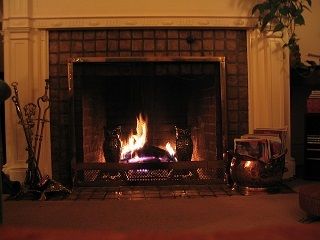From Guest Blogger Izzie: Fires vs. Central Heating – Which Is Better for the Environment?

But for the environmentally conscious among us, there are some questions that bear pondering. For example, the topic of our article today – is it better to use fireplaces or central heating when it comes to heating our homes?
Most homes will have both options available, with some exceptions and differences. Weighing up which is better for the environment, at least in your current living situation, involves a lot of key factors. We’re going to cover a few today, in hopes of painting the best picture, from which you can draw the information relevant to you.
Fuel efficiency
First and foremost, this is a question of efficiency. We are throwing out wood and other solid fuel burning stoves from the offset, as they clearly have specific environmental impacts that would require a whole other article to explore. So this is a battle between central heating and radiators, and either electric or gas fireplaces.
Gas fireplaces range in their efficiency. Though they use the same fuel as central heating, gas fireplaces can have very poor efficiency rates, averaging about 50%-60%, and dropping as low as 30%. Central heating, on the other hand, averages about 90%. Electric fireplaces on the other hand are 100% efficient. Combine that with solar energy panels on your roof, and you have a pretty unbeatable combination.
Cost vs. Usage
Installing a central heating system can be quite expensive, especially if you are renovating an old, large house. Similarly, fireplaces can get quite pricey, with wall mounted units running into the thousands. But once again taking out the bottom line cost, it is relevant to the discussion to weigh up the expense vs. the potential usage.
Both fireplaces and central heating systems require maintenance. That is unavoidable. Instead, we’re looking at the extremes. For example, fireplaces are unlike to outlast a central heating system. Replacing these units every few years will have a much bigger environmental impact than just having the central heating system.
That said, a central heating system uses more materials, so if it is rarely used, that is a very unnecessary impact on the ecosystem. In fact, it is well worth researching which materials get used in both fireplaces and central heating systems. If you can find eco-friendly units, or avoid very harmful units, this can help immeasurably.
Big house vs. Small house
A final thing to consider is the size of your house. Central heating tends to be a binary choice – you either heat the entire house, or nothing at all. Fireplaces, on the other hand, can be turned on and off in certain rooms. Which is better for the environment will depend on the size of your house.
Small house are generally better off using central heating. The difference in fuel consumption is marginal, and if you’re using an inefficient gas fire, it may actually be more beneficial to use the central heating. For big homes, on the other hand, fireplaces may be the way to go. The sheer amount of fuel needed to heat a home that big means that heating the whole thing is very environmentally harmful if there are only a few people in the house. You are much better off heating individual rooms instead.

I am not sure where Izzie is writing from, but across much of the US, there is a need for summer cooling as well as for winter heating.
Where this is the case, I would say by far the lowest impact system is likely to be use of high efficiency inverter controlled reverse cycle air conditioning units – capable of both heating and cooling with a high degree of efficiency – that way, one system rather than two, and both services provided with exceptional efficiency.
This can be supplemented by thermostatically controlled solar air heaters such as this
http://www.solarshop.co.uk/solar-powered-ventilation/solar-energy-panel-XL400.html
(This is a commercial model, but those with the time and skills can make their own)